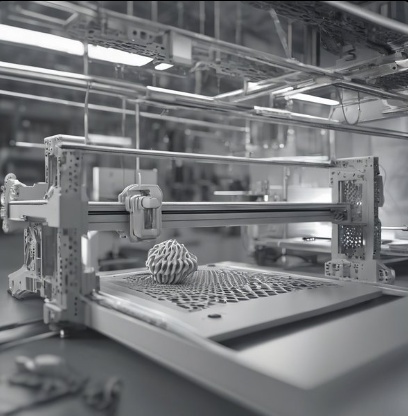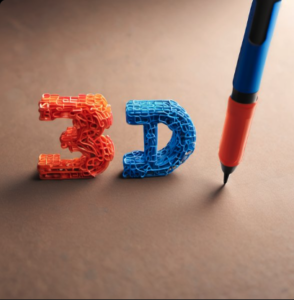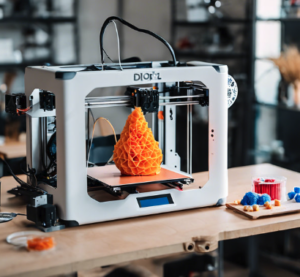The Rise of Hybrid 3D Printing Technologies: Merging Tradition with Innovation

Over the past few years, 3D printing, also known as additive manufacturing (AM), has revolutionized industries by offering rapid prototyping and producing parts with complex geometries that traditional methods cannot achieve. However, as the demand for faster, more efficient, and cost-effective manufacturing solutions has grown, a new approach has emerged: Hybrid 3D Printing.
Hybrid 3D printing refers to systems that combine additive manufacturing with traditional subtractive processes, such as milling or CNC (Computer Numerical Control) machining, within the same machine. This convergence of technologies allows manufacturers to leverage the benefits of both methods—additive’s flexibility and complexity and subtractive’s precision and finishing ability.
In this article, we will explore the fundamentals of hybrid 3D printing, the key benefits it offers, its applications across industries, the technologies behind it, as well as the challenges and future outlook for hybrid systems in the manufacturing landscape.
What is Hybrid 3D Printing?
Hybrid 3D printing is a manufacturing technique that integrates both additive and subtractive processes. The additive process, typically 3D printing, involves building up material layer by layer to create a part, while the subtractive process involves removing material from a solid block using tools like CNC milling, turning, or grinding.
Hybrid systems combine these two processes within a single machine, which can print parts and then use subtractive methods to refine and finish them, often to achieve better surface finishes, tighter tolerances, or specific mechanical properties. The result is a highly customizable, precise, and efficient manufacturing process that can produce more complex parts than traditional subtractive or additive methods alone.
Key Technologies Involved in Hybrid 3D Printing
The key technologies driving hybrid 3D printing include:
- Laser-Based 3D Printing: This technique, including Selective Laser Sintering (SLS) or Direct Metal Laser Sintering (DMLS), is often paired with subtractive machining for parts that require high precision.
- Fused Deposition Modeling (FDM): Used for printing prototypes, parts can be further refined with CNC machining in hybrid systems.
- CNC Milling/Turning: These subtractive processes are integrated into hybrid systems to perform finishing operations after a part is 3D printed.
- Ultrasonic Additive Manufacturing (UAM): Involves ultrasonic vibrations for adding layers, and it is paired with traditional machining for enhanced material properties.
By combining these technologies, hybrid systems enable the production of high-precision, complex parts, especially for industries requiring detailed and durable components, such as aerospace, healthcare, and automotive.
Key Benefits of Hybrid 3D Printing Technologies
Hybrid 3D printing offers several advantages over using additive or subtractive methods in isolation. The most significant benefits include:
1. Increased Precision and Accuracy
One of the most notable benefits of hybrid 3D printing is the ability to achieve higher precision and accuracy. Traditional 3D printing methods can create complex geometries, but the surface finish and precision may not meet the strict requirements of industries like aerospace or medical device manufacturing. By integrating subtractive processes like CNC machining, hybrid systems can refine the surface finish and improve dimensional accuracy, enabling manufacturers to create parts that meet stringent tolerances.
For example, a hybrid system could 3D print a part with intricate internal structures and then use CNC milling to finish the outer surfaces, achieving the exact shape and surface quality needed for its application.
2. Material Versatility
Hybrid systems are capable of handling a wide range of materials, which gives manufacturers greater flexibility. Materials used in additive manufacturing (e.g., thermoplastics, metals) can be combined with materials traditionally processed by subtractive techniques (e.g., high-strength alloys, composites). This versatility allows for the creation of parts with unique properties, such as lightweight yet durable structures for the aerospace industry or biocompatible materials for medical implants.
Hybrid systems also allow manufacturers to print parts with different materials in a single build. For example, an automotive part could be printed with lightweight material for internal structures and then coated with a more durable material for external surfaces.
3. Cost Efficiency
Hybrid 3D printing can reduce production costs in multiple ways. Traditional manufacturing methods often involve multiple stages, such as casting, machining, and finishing, all of which contribute to high labor and material costs. Hybrid systems simplify this process by combining additive and subtractive techniques in one workflow, cutting down on production time, reducing material waste, and minimizing the need for additional post-processing.
Furthermore, hybrid systems reduce the need for multiple machines. Instead of using a separate 3D printer, CNC machine, and finishing station, manufacturers can use a single hybrid machine to complete all stages of production, streamlining workflows and saving money.
4. Faster Production Times
Hybrid 3D printing systems can reduce production times compared to traditional methods. 3D printing allows for rapid prototyping and quick production of parts with complex geometries, while the subtractive process can be used for finishing the part quickly once it’s printed. Combining these processes within the same machine eliminates the need for separate post-processing steps, speeding up the overall manufacturing cycle.
For instance, automotive manufacturers can rapidly prototype parts using 3D printing and then use milling or turning to fine-tune the details, ultimately reducing the time it takes to move from design to production.
5. Customization and Complexity
Hybrid systems excel in producing highly customized, complex parts. Industries like healthcare, aerospace, and automotive often require unique components that must meet specific performance criteria, including lightweight structures, strength, and tailored geometries. Hybrid printing allows for complex internal structures and geometries that are difficult or impossible to create with traditional manufacturing, all while ensuring the final part meets required specifications.
For instance, in healthcare, customized implants can be designed to perfectly match a patient’s anatomy, while the surface finish can be refined using subtractive techniques to improve biocompatibility.
Industry Applications of Hybrid 3D Printing
Hybrid 3D printing has found applications in several industries, particularly those that require high precision, complex parts, and fast production times.
1. Aerospace
The aerospace industry has embraced hybrid 3D printing due to its ability to produce lightweight, high-strength components. Parts like turbine blades, engine components, and structural components require high precision and minimal weight. Hybrid systems enable manufacturers to 3D print complex internal geometries (such as cooling channels within turbine blades) and then use subtractive techniques like CNC machining to refine the part for optimal strength and precision.
Companies like GE Aviation use hybrid 3D printing to create fuel nozzles that are lighter, more durable, and more fuel-efficient than traditional nozzles.
2. Automotive
In the automotive industry, hybrid systems are used for rapid prototyping, tooling, and even production of final parts. Hybrid 3D printing allows automakers to quickly design and prototype components with complex geometries, which can then be refined using traditional subtractive methods. This reduces the time and cost associated with producing parts for new car models.
Hybrid systems also allow automakers to produce small-batch, customized components for electric vehicles (EVs), such as lightweight, high-performance parts that help improve energy efficiency.
3. Healthcare
Healthcare is one of the most promising sectors for hybrid 3D printing, especially for producing customized prosthetics, implants, and medical tools. Hybrid systems allow for the creation of implants with intricate geometries that fit a patient’s unique anatomy. Once 3D printed, these implants can be further refined using CNC machining to ensure precise fit and finish.
For example, hybrid systems can produce complex hip implants, where the internal structure is 3D printed to maximize strength-to-weight ratios, and the surface finish is refined to ensure compatibility with human tissue.
4. Consumer Goods
Hybrid 3D printing has begun to play a role in the consumer goods industry, particularly in areas such as custom jewelry, eyewear, and fashion accessories. These products often require intricate designs and unique materials. Hybrid systems allow manufacturers to print highly detailed parts and then finish them with traditional machining techniques, improving the overall quality and customer satisfaction.
For example, jewelry manufacturers use hybrid 3D printing to create highly detailed designs that are then polished and refined using subtractive processes to create a premium finish.
Leading Companies and Technologies
Several companies are at the forefront of hybrid 3D printing technology, including:
- Stratasys: Their F900 system integrates FDM (Fused Deposition Modeling) 3D printing with CNC machining, allowing manufacturers to print and refine parts in one workflow.
- 3D Systems: Their ProX DMP 320 combines metal 3D printing with CNC machining to produce high-precision metal parts for aerospace and medical applications.
- Siemens: Siemens offers NX software solutions that support hybrid manufacturing, integrating both additive and subtractive processes in industrial applications.
These companies are pushing the boundaries of hybrid manufacturing by offering machines and software that streamline workflows and make hybrid systems more accessible.
Challenges and Limitations of Hybrid 3D Printing
Despite its numerous benefits, hybrid 3D printing faces several challenges:
Technical Challenges
Integrating additive and subtractive processes within a single system requires advanced engineering. These hybrid machines must seamlessly combine the different technologies, which can be complex. Achieving optimal results requires precise calibration, sophisticated software, and a high level of expertise from operators.
Material Compatibility
Materials used in 3D printing may not always be compatible with traditional machining processes. Some 3D printed materials may not have the necessary properties to withstand subtractive techniques, or the interface between additive and subtractive materials may not always be ideal for certain applications.
High Initial Costs
Hybrid 3D printing systems are still relatively new, and their initial cost can be high. While these systems can save money in the long run by combining processes, the upfront investment may be a barrier for small and medium-sized enterprises (SMEs).
The Future of Hybrid 3D Printing
Looking ahead, the future of hybrid 3D printing appears promising. As technology advances, we can expect to see more affordable, user-friendly hybrid systems capable of producing even more complex parts with a wider variety of materials. Automation, AI, and advanced material science will further enhance the capabilities of hybrid systems, allowing them to achieve faster production times and greater precision.
Hybrid 3D printing is set to become a core technology in industries that demand customized, high-performance parts, with increasing adoption across sectors such as aerospace, automotive, healthcare, and manufacturing.
Hybrid 3D printing combines the best of both additive and subtractive manufacturing, offering a versatile, efficient, and cost-effective solution for producing high-precision, complex parts. As industries continue to demand faster production, higher customization, and more robust components, hybrid systems are poised to play a key role in reshaping the future of manufacturing. While challenges remain, the potential of hybrid 3D printing to transform industries from aerospace to healthcare is undeniable.
Visit our other website: https://synergypublish.com






